If there’s one aspect of Vintage and Legacy that distinguishes them from other formats, it’s their access to cheap, powerful card selection. In Vintage, while most of the good tutors are restricted, it is still a rare pleasure to play with cards like “Demonic Tutor,” something you cannot do anywhere else except in Commander. In Legacy, we have access to the two most powerful cantrips ever printed, Brainstorm and Ponder, as four-ofs. Because Legacy doesn’t have access to the most powerful tutors ever printed, the defining sources of card selection in Legacy are blue cantrips or cards that perform similar actions like Sensei’s Divining Top. In this article we’ll dig into the function of cantrips in the respective archetypes that use them, and also demonstrate how card selection is more crucial than card advantage in the context of Legacy due to the sheer efficiency of the former over the latter. In addition to theorizing about cantrips, we’ll also examine how the repeatable selection effect of Sensei’s Divining Top is integral in explaining Miracles’ success as a control deck, and then we’ll move on to the issues with Dig Through Time.
The General Function of Cantrips with Respect to Common Archetypes
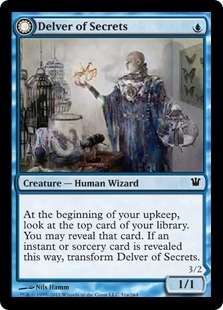 In general, Legacy’s cantrips enable decks to search for a relevant card in a given game state at the cost of a card and one mana. However, the roles cantrips play in certain decks varies according to the archetype using them. For the purposes of this article, I will limit my discussion to three categories of archetypes: 1. Tempo 2. Combo 3. Blue Midrange/ Control. Obviously, these categories can intersect in certain decks, but to keep my analysis clean I will keep them separate.
In general, Legacy’s cantrips enable decks to search for a relevant card in a given game state at the cost of a card and one mana. However, the roles cantrips play in certain decks varies according to the archetype using them. For the purposes of this article, I will limit my discussion to three categories of archetypes: 1. Tempo 2. Combo 3. Blue Midrange/ Control. Obviously, these categories can intersect in certain decks, but to keep my analysis clean I will keep them separate.
1. Tempo: the general game plan of these decks is to play one or two threats and ride them to victory while disrupting the opponent’s game plan. As my friend Ben would always say while having an Insectile Aberration or Tarmogoyf in play, “I’m trying to kill you” after doing something like casting Spell Pierce against a Pernicious Deed. In these decks cantrips function primarily as cards that either find threats, or find the necessary disruption that keeps the opponent’s game plan off balance, or answer your opponent’s attempts to deal with your threats long enough for them to get the job done.
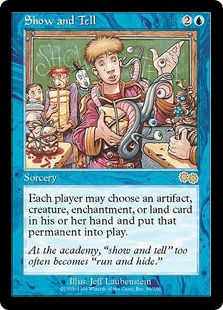 2. Combo: In combo decks the function of cantrips is generally to find either pieces you need for your combo, or protection to force through a game-breaking spell or sequence of spells. Protection usually comes in the form of counterspells or discard, but they can also include anti-hate cards like Xantid Swarm, Defense Grid, or bounce spells (Chain of Vapor, for example). Also, cantrips tend to be played much more aggressively in combo decks than any other archetype because their game plan hinges so much on finding specific cards to enact their game plan. This is why you’ll see combo players opt to play so-called “bad Brainstorms” without having a fetchland. They aren’t trying to get value so much as find what will kill you, or cards that will make sure you can’t impede their game plan of killing you.
2. Combo: In combo decks the function of cantrips is generally to find either pieces you need for your combo, or protection to force through a game-breaking spell or sequence of spells. Protection usually comes in the form of counterspells or discard, but they can also include anti-hate cards like Xantid Swarm, Defense Grid, or bounce spells (Chain of Vapor, for example). Also, cantrips tend to be played much more aggressively in combo decks than any other archetype because their game plan hinges so much on finding specific cards to enact their game plan. This is why you’ll see combo players opt to play so-called “bad Brainstorms” without having a fetchland. They aren’t trying to get value so much as find what will kill you, or cards that will make sure you can’t impede their game plan of killing you.
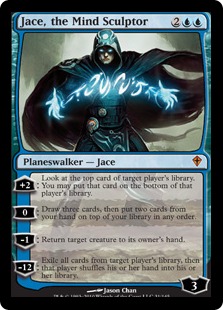 3. Blue Midrange/ Control: In relation to this archetype, I am mainly referring to the most prominent midrange/ control decks at the moment: Shardless BUG, Stoneblade variants, Grixis Pyromancer, and Miracles. All of these decks play varying amounts of cantrips. At the minimum they play Brainstorm. The most extreme case is Grixis Pyromancer, which one might describe as almost a pile of cantrips since it plays Brainstorm, Ponder, Preordain, and Gitaxian Probe to fuel Young Pyromancer and Dig Through Time primarily. Still, the basic function of cantrips in all of these decks can be boiled down to the following four points: first off, you want to reliably hit land drops, but also be able to ship extra lands to mitigate against potential mana flood. This is a general characteristic of any deck using cantrips, but especially important for blue midrange/ control decks, as they run more lands than most decks and need to hit land drops in the early game to be able to continue to ‘curve out’ as the game goes on. Second, you want to find the right answers to your opponent’s questions. Third, to find sources of card advantage. Finally, to grab win conditions once the board is stabilized, or when you want to shift into a more proactive role against either opposing midrange/ control decks or combo.
3. Blue Midrange/ Control: In relation to this archetype, I am mainly referring to the most prominent midrange/ control decks at the moment: Shardless BUG, Stoneblade variants, Grixis Pyromancer, and Miracles. All of these decks play varying amounts of cantrips. At the minimum they play Brainstorm. The most extreme case is Grixis Pyromancer, which one might describe as almost a pile of cantrips since it plays Brainstorm, Ponder, Preordain, and Gitaxian Probe to fuel Young Pyromancer and Dig Through Time primarily. Still, the basic function of cantrips in all of these decks can be boiled down to the following four points: first off, you want to reliably hit land drops, but also be able to ship extra lands to mitigate against potential mana flood. This is a general characteristic of any deck using cantrips, but especially important for blue midrange/ control decks, as they run more lands than most decks and need to hit land drops in the early game to be able to continue to ‘curve out’ as the game goes on. Second, you want to find the right answers to your opponent’s questions. Third, to find sources of card advantage. Finally, to grab win conditions once the board is stabilized, or when you want to shift into a more proactive role against either opposing midrange/ control decks or combo.
Card Selection vs. Card Advantage
Now that we’ve talked about the function of cantrips with respect to Legacy’s most common archetypes, I would like to bring up a more general theoretical point: comparing card selection to card advantage. Within the context of Legacy, I would argue that card selection is more critical than card advantage most of the time. To understand this point, let’s analyze what card advantage does for a deck by looking at one of the decks built around this fundamental concept: Shardless BUG. The deck’s center piece is Shardless Agent, cascading into Ancestral Visions. Such a sequence is the best case scenario, but the deck is designed around the cascade mechanic so that your cascades are usually decent to good, even without setup from Brainstorming. Generally, one might describe Shardless BUG as a midrange control deck (I also like the description “pile of value” in an affectionate sense) that seeks to survive into the mid and late game to drown its opponent in card advantage via 2-for-1’s and permanent based card advantage from planeswalkers (including Deathrite Shaman, dat one mana planeswalker).
However, there is a tradeoff you make in having your deck focus on generating card advantage – time. In other words, your deck is inherently slower while waiting for the card advantage mechanisms to kick in, and thus potentially vulnerable to more aggressive game plans from your opponents. In Legacy this usually means either a tempo Delver variant or a combo deck. In the case of Shardless BUG, the deck is generally soft to combo, at least pre-board. Against Delver decks, the deck tends to perform well, but some draws can make you vulnerable to a quick tempo deck, especially if they have Stifle coupled with a Wasteland. Due to the fast and powerful nature of the format, most decks need to run a good amount of cheap disruption to interact with their opponent, regardless of how fast or slow they are. This is why Shardless BUG runs cards like Abrupt Decay, discard spells (ala Thoughtseize and/or Hymn to Tourach), and Force of Will, despite the latter generating card disadvantage. The exceptions to this rule of running cheap interaction are glass canon combo decks like Belcher and Oops All Spells, who run little to no disruption because most of their slots are dedicated to going off as fast as possible. Thankfully these decks are kept in check to the point of seeing very little play due to the omnipresent Force of Will.
But, in making a deck that seeks to generate card advantage, we need another way to sift through our deck to draw into what we need in a given game state, preferably cheaper than our ways to generate card advantage. This is where cantrips fill in the gap. In lieu of leaning on card advantage to draw into the right answers, control decks in Legacy are incentivized by the card pool and nature of the format to play some number of cantrips. At minimum you play Brainstorm, because of the sheer efficiency of the card in terms of card selection. The exceptions to this are control decks that are either not blue, or by the card choices of their deck choose not to play even Brainstorm. A notable example of the latter is UBx Tezzerator, which trades the power of cantrips for the ability to shut down other-cantrip laden decks with Chalice of the Void. Otherwise, control decks are almost required to play some number of cantrips to keep up with the format to be able consistently function in a format as fast and powerful as Legacy. The reason for this is because the ways to generate card advantage are typically slow. This means decks cannot rely solely on their means of generating card advantage to draw into what they need for a given game state. This is why card selection tends to be more crucial for a deck to function consistently in a format as fast and powerful as legacy even if the deck’s game plan involves generating card advantage. In other words, paying one to “draw three, put two back” is often better than a three mana Ancestral Recall since the former costs one. Within the context of Legacy the difference between a spell costing one and three is huge considering all the powerful plays that can be made in the early game.
Explaining Miracles’ Success With Respect to ‘Cantripping’
Now that we’ve talked about the function of cantrips in terms of Legacy’s most common archetypes and how they are more important than card advantage in a certain sense, I want to talk about a crucial element of what make’s Miracles so successful, despite the fluctuations in the Legacy format in recent years. For reference, here is a pretty stock 4 Ponder list piloted by Sam Roukas to a 10th place finish at SCG Worcester:
Miracles,
| [Business] (39) 4 Force of Will 1 Pyroblast 1 Counterspell 4 Counterbalance 4 Sensei's Divining Top 4 Brainstorm 4 Ponder 2 Jace, the Mind Sculptor 2 Dig Through Time 3 Swords to Plowshares 4 Terminus 1 Council's Judgment 2 Entreat the Angels 3 Snapcaster Mage [/Business] (0) [Mana Sources] (21) 1 Karakas 4 Flooded Strand 4 Polluted Delta 1 Arid Mesa 3 Tundra 2 Volcanic 4 Island 2 Plains [/Mana Sources] (0) | [Sideboard] (15) 1 Engineered Explosives 2 Grafdigger's Cage 1 Relic of Progenitus 2 Monastery Mentor 2 Flusterstorm 1 Pyroblast 2 Red Elemental Blast 1 Wear // Tear 3 Vendilion Clique[/Sideboard] |
In analyzing Miracles’ success in Legacy, let’s take a closer look at how the type of card selection that is built in to Miracles allows it to function and prosper. All builds run Brainstorm, not only to smooth out draws, but because of its powerful synergy with the Miracle mechanic, and the synergy with being able to manipulate and leverage Counterbalance’s triggered effect. Many lists are now running the full 4 Ponders as well, first heartily promoted by Philipp Schönegger. This further allows the deck to have a consistent first turn play, as well as further cheat on mana sources. However, it would be a crime to not talk about the core card of this deck, Sensei’s Divining Top. Why is Sensei’s Divining Top so instrumental to this deck’s success? The fact of the matter is when you invest one mana to cast it, it literally does nothing at first, incurring a minor tempo loss. You need to invest another mana in it to each turn to extract any real value from it. This is the reason that many tempo-based decks choose not play Top, but the recurring card selection and card quality offered by it allows more manipulation of a deck than any other card in Magic. Combined with fetchlands, the Sensei’s Divining Top player is able to see an astounding number of cards each game, and this is why you’ll see most Miracles players conserving their fetchlands use, in order to maximize selection opportunity. Miracles doesn’t necessarily need the raw card drawing power of something like Ancestral Visions or Standstill, when it can trade one for one more frequently, by being able to more reliably find answers, and then hopefully take over the game via a Terminus, Entreat the Angels, or Jace, the Mind Sculptor. The card advantage will eventually take over if allowed to, but the card selection is the most important thing in even getting the deck’s pilot to that stage.
It is curious that Legacy’s best control deck would have at its core something that is a distinctive feature of the format, card selection via “cantripping.” I, however, do not think this is actually a coincidence. I think that Sensei’s Divining Top is at the very core of Miracles success as a control deck. Even Philipp Schönegger himself stated in Every Day Eternal’s “Miracle Men” podcast that Miracles is not a Counterbalance deck or a Miracles deck, but a “Sensei’s Divining Top deck” with Counterbalance and Miracle cards. To see where I’m coming from, consider Miracles’ cheapest sources of card advantage: Counterbalance and Terminus. Without Sensei’s Divining Top these cards are unplayable. Sure, many builds of Miracles play Dig Through Time now, but this card is not as essential as Sensei’s Divining Top paired with Counterbalance and Terminus. After considering these cards, if we were to look at other common sources of card advantage, they start to get more expensive. Snapcaster Mage costs at least three mana to extract value from, and Jace, the Mind Sculptor costs four mana. The respective costs of these cards makes them typically late game sources of card advantage. By contrast, since Counterbalance and Terminus cost two and one respectively, they allow Miracles to try and enact its card advantage game plan in the early game if a given player should need to. However, none of this would be possible without Sensei’s Divining Top. This card, along with its synergies with Counterbalance and Miracles, and all the other powerful cards Miracles has access to, allow the deck to reach a balance between power and consistency that is unparalleled compared to most other Legacy decks, only matched by OmniTell at the moment.
All this talk of cantrips and how they affect Legacy, and I still haven’t really talked about the elephant in the room? Don’t worry, I’m getting to that now.
The Problems with Dig Through Time
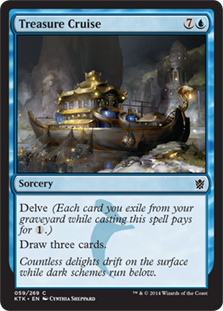 With the release of Khans of Tarkir last year, we got our hands on two very powerful blue draw spells, Treasure Cruise and Dig Through Time. We already know the story ends for Ancestral Recall 2.0, but we’re still currently going through the story arc of Dig Through Time. Ever since Treasure Cruise was banned in January, Dig Through Time has taken its place as a card that is clearly warping the format around it. In what sense is this happening though? Why is it happening? To answer these questions it is worth revisiting why Treasure Cruise was so utterly broken. Treasure Cruise is Wizard’s latest attempt to make an Ancestral Recall effect that is fairer than the original. The most notable iteration of this prior to Treasure Cruise is Ancestral Visions. This time around, their way of doing this is the Delve mechanic, which ends up making Treasure Cruise infinitely more broken than Ancestral Visions ever was. The reason for this is due to how, in Eternal formats, there are so many cheap spells that are already being cast that is pretty easy to quickly fuel a spell with Delve. You just get rewarded for playing Magic really. In the context of Legacy, this is especially true with pretty much every blue deck running cantrips. So the problem with Treasure Cruise is also a problem with the Delve mechanic itself.
With the release of Khans of Tarkir last year, we got our hands on two very powerful blue draw spells, Treasure Cruise and Dig Through Time. We already know the story ends for Ancestral Recall 2.0, but we’re still currently going through the story arc of Dig Through Time. Ever since Treasure Cruise was banned in January, Dig Through Time has taken its place as a card that is clearly warping the format around it. In what sense is this happening though? Why is it happening? To answer these questions it is worth revisiting why Treasure Cruise was so utterly broken. Treasure Cruise is Wizard’s latest attempt to make an Ancestral Recall effect that is fairer than the original. The most notable iteration of this prior to Treasure Cruise is Ancestral Visions. This time around, their way of doing this is the Delve mechanic, which ends up making Treasure Cruise infinitely more broken than Ancestral Visions ever was. The reason for this is due to how, in Eternal formats, there are so many cheap spells that are already being cast that is pretty easy to quickly fuel a spell with Delve. You just get rewarded for playing Magic really. In the context of Legacy, this is especially true with pretty much every blue deck running cantrips. So the problem with Treasure Cruise is also a problem with the Delve mechanic itself.
We already know what happens when you let people play with 4 Ancestral Recalls in Legacy: the meta devolves into turbo tempo decks like UR Delver and Blue Midrange with Treasure Cruise vs. Miracles and Combo, the only decks powerful and consistent enough to keep up with these decks. Nearly everything else was pushed out, if consistent tournament results were any measure. The metagame morphing into this is not too surprising since Treasure Cruise, from a deck design perspective, incentivized people to play either tempo or blue midrange, decks that don’t really care about specific cards, and love having something like a one mana draw three to refill their hands (and subsequently, the graveyard again and again).
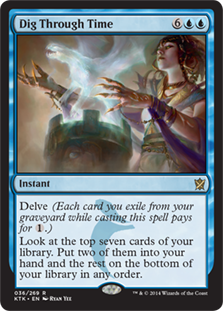 Now that we’ve discussed the core issues with Treasure Cruise, the question remains how do these issues relate to Dig Through Time? Since Dig Through Time is another Delve draw spell like Treasure Cruise, the Delve problem is fairly obvious. What distinguishes Dig Through Time from Treasure Cruise is the decks it pushes. Unlike Treasure Cruise, we are not seeing Delver decks at the top the format. With Treasure Cruise no longer overshadowing Dig Through Time, the archetypes that are over-represented are control decks (mainly Miracles, though I think hard Grixis Control with Dig Through Time might be a thing), Blue midrange of a controlling nature (Stoneblade, Grixis Pyromancer, etc.), and combo decks (mainly OmniTell and ANT).
Now that we’ve discussed the core issues with Treasure Cruise, the question remains how do these issues relate to Dig Through Time? Since Dig Through Time is another Delve draw spell like Treasure Cruise, the Delve problem is fairly obvious. What distinguishes Dig Through Time from Treasure Cruise is the decks it pushes. Unlike Treasure Cruise, we are not seeing Delver decks at the top the format. With Treasure Cruise no longer overshadowing Dig Through Time, the archetypes that are over-represented are control decks (mainly Miracles, though I think hard Grixis Control with Dig Through Time might be a thing), Blue midrange of a controlling nature (Stoneblade, Grixis Pyromancer, etc.), and combo decks (mainly OmniTell and ANT).
And so, Dig Through Time is having a similar effect that Treasure Cruise had on the metagame, since it’s a powerful and cheap source of card advantage that can slot into just about any blue deck. The only difference is the archetypes it pushes. Don’t get me wrong, I kind of like a meta mostly consisting of combo and control as those are the archetypes I gravitate towards most personally. However, were it my decision I would still probably opt to ban Dig Through Time since this state of affairs would get boring in the long run. Unfortunately, we can’t dig through time to see if the Impulse on steroids will remain with us past the next few Banned & Restricted List announcements. However, I’m sure many would agree with me when I say the results of GP Lille will give us a very good indicator of whether this card is long for this world or not.
Thank you for reading, and a special thanks to a few of my friends who read a draft of this article to give me input on it. I hope you all enjoyed it. If you have anything to say on what I discussed in this article or input for future ones, let me know. Also, if you liked what you read, I’d appreciate it if you shared it anywhere and with anyone you can. Lastly, to digest more good discussion on the problems with Dig Through Time, be on the lookout for Everyday Eternal’s next podcast. Cheers.
